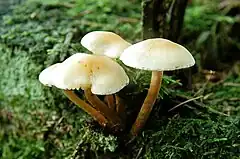Gymnopus
Gymnopus is a genus of fungus in the family Omphalotaceae. The genus has a widespread, cosmopolitan distribution and contains about 300 species.[1]
| Gymnopus | |
|---|---|
 | |
| Gymnopus dryophilus | |
| Scientific classification | |
| Kingdom: | |
| Division: | |
| Class: | |
| Order: | |
| Family: | |
| Genus: | Gymnopus |
| Type species | |
| Gymnopus fusipes | |
| Species | |
|
~ 300 | |
| Synonyms | |
History and classification
The type species for the Gymnopus, Gymnopus fusipes, dates back to 1806 [(Pers.) Roussel].[2] Many of the species now classified in the Gymnopus genera were once assigned to Collybia. In 1997 it was suggested that the Collybia genus be split into three genera, one of them being Gymnopus.[3][4]
Description
In general, Gymnopus fruiting bodies are found in leaf and woody litter. Typically the fruiting bodies are relatively small and range from browns to white in color.[4][5] Their spore deposit is white.[6] Most species of gymnopus act as decomposers (saprotrophic).[7] With one known exception (G. subnudus), the mating patterns of gymnopus all seem to be bifactorial, meaning that there is more than one locus responsible for regulating mating compatibility.[8][9]
Representative species
- Gymnopus dryophilus
- Gymnopus fusipes
- Gymnopus peronatus
- Gymnopus semihirtipes
- Gymnopus quercophilus
See also
References
- Kirk PM, Cannon PF, Minter DW, Stalpers JA (2008). Dictionary of the Fungi (10th ed.). Wallingford, UK: CABI. p. 298. ISBN 978-0-85199-826-8.
- de Roussel, Henri François Anne (1806). Flore du Calvados et terrains adjacents, composée suivant la méthode de Jussieu [Flora of Calvados and adjacent areas, according to the method of Jussieu] (in French) (2nd ed.). Caen: Poisson. p. 62.
- "Antonín, V.; Noordeloos, M.E. 1997. A monograph of Marasmius, Collybia and related genera in Europe. Part 2: Collybia, Gymnopus, Rhodocollybia, Crinipellis, Chaetocalathus, and additions to Marasmiellus. Libri Botanici. 17:1-256". www.mycobank.org. Retrieved 2019-03-28.
- Mata, JL & Ovrebo, C (2009). "New reports and illustrations of Gymnopus for Costa Rica and Panama" (PDF). Fungal Diversity. 38: 125–131.
- Murphy, John F.; Miller, Orson K. (1993). "The Population Biology of Two Litter Decomposing Agarics on a Southern Appalachian Mountain". Mycologia. 85 (5): 769–776. doi:10.2307/3760608. ISSN 0027-5514. JSTOR 3760608.
- H Knudsen; J Vesterholt (2012). Funga Nordica. Copenhagen: Nordsvamp. p. 342. ISBN 978-87-983961-3-0.
- RH Petersen & KW Hughes (2014). "New North American species of Gymnopus". North American Fungi. 9: 1–22. doi:10.2509/naf2014.009.003.
- BPS Nieuwenhuis; S Billiard; S Vuilleumier; E Petit; ME Hood & T Giraud (2013). "Evolution of uni- and bifactorial sexual compatibility systems in fungi". Heredity (Edinb). 111 (6): 445–455. doi:10.1038/hdy.2013.67. PMC 3833681. PMID 23838688.
- JL Mata; RE Halling; RH Petersen (2004). "New species and mating system reports in Gymnopus (Agaricales) from Costa Rica" (PDF). Fungal Diversity. 16: 113–129.
Further reading
- Mata JL, Hughes KW, Petersen RH (2006). "An investigation of Omphalotaceae (Fungi : Euagarics) with emphasis on the genus Gymnopus" (PDF). Sydowia. 58 (2): 191–289.